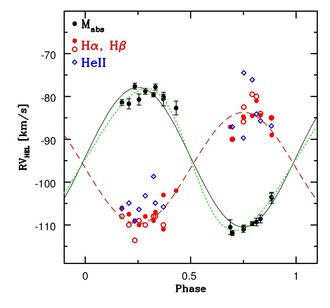
Recurrent novae are novae with two or more thermonuclear explosions recorded. They should contain massive white dwarfs (WDs) accreting at very high rates in order to build critical-mass envelopes quickly enough to erupt so frequently. Those with evolved giant donors called symbiotic recurrent novae with their massive WDs and high accretion rates are promising candidates for the SNIa via single-degenerate (SD) channel provided that they contain carbon-oxygen (CO) WDs which can grow secularly in mass to approach the Chandrasekhar limit and ignite carbon burning to produce an SNIa. Recent theoretical simulations show that the SD symbiotic channel could produce SNe Ia with intermediate and old ages, contributing up to 5% of all SNIa in the Galaxy.
The team led by Joanna Mikołajewska (CAMK) has recently combined optical photometry and high resolution SALT spectra of the symbiotic recurrent nova V3890 Sgr at quiescence, and they have determined the orbital period to be 747.6 days. Double-line spectroscopic orbits in the system indicate that the component masses are MWD ≈1.35 M⊙ and Mg ≈1.05 M⊙. The orbit inclination is ≈67-69O. The red giant is filling (or nearly filling) its Roche lobe, and the distance set by its Roche lobe radius, d≈9 kpc, is consistent with that resulting from the giant pulsation period. The outburst magnitude of V3890 Sgr is then very similar to those of RNe in the Large Magellanic Cloud. V3890 Sgr shows remarkable photometric and spectroscopic activity between the nova eruptions on timescales of years.The active source has a double-temperature structure which has been associated with the presence of an accretion disc. The activity would be then caused by changes in the accretion rate. The paper also provides evidence that V3890 Sgr contains a CO WD accreting at a high, a few × 10-8–10-7 M⊙/yr, rate. The WD is growing in mass, and should give rise to a SNIa within ≲106 yrs - the expected lifetime of the red giant.
The paper describing these findings "The symbiotic recurrent nova V3890 Sgr: binary parameters and pre-outburst activity" has been accepted for publication in MNRAS.
Figure caption: Radial velocity curves phased with the orbital period and orbital solutions for the M giant absorption lines and the WD traced by broad emission line wings.
Text and figure: Joanna Mikołajewska






